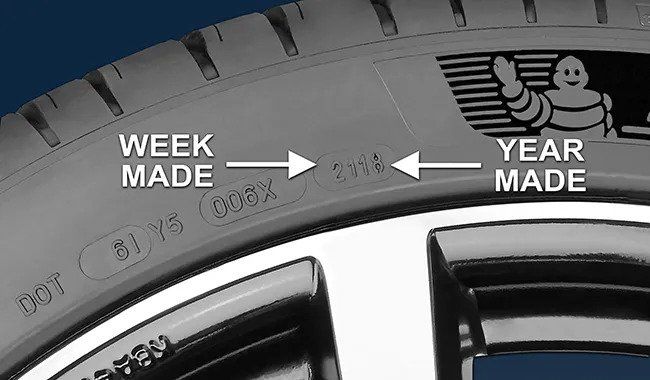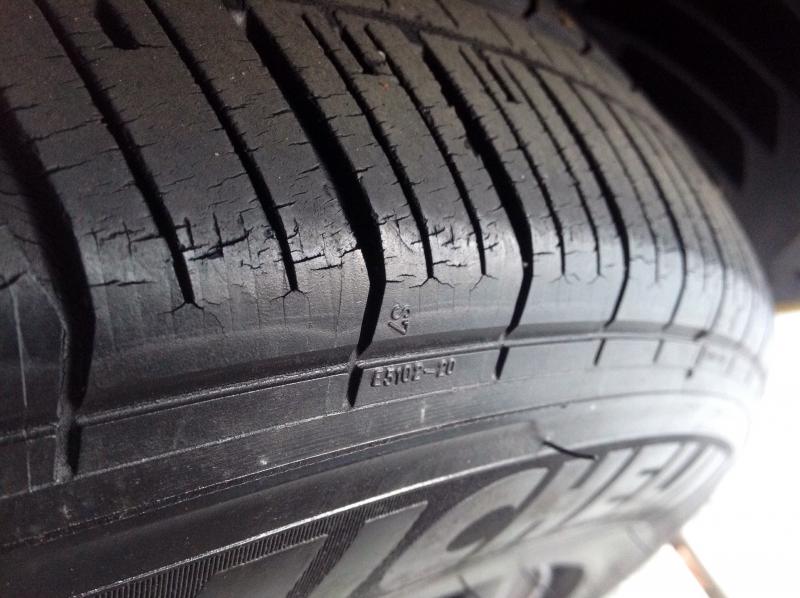Tire Date Codes - Date Code On A Tire The DOT Tire Identification Number
DOT Tire Identification Number
The U.S. Department of Transportation (DOT) requires that every tire manufacturer provide a standardized identification number or code. This consists of the manufacturer's plant code, the tire size, brand, and the week/year the tire was made.
How To Determine The Age Of Your Tires
Along with understanding tire basics like pressures, tread depth, and tire type, you should know the age of your tires. This is important because riding on tires Ten years or older could potentially be dangerous.
Similar to other tire wear and performance factors, age can and will affect the performance of tires, and therefore overall vehicle safety and capability.
Not sure how old your current tires are? No worries, we’ll show you how to easily find out.
Tires manufactured after 2000
“Stamped” on the outer sidewall of each tire is its birth date in a straightforward week/year format.
Scan the tire sidewall in a clockwise pattern and find the letters “DOT” (which signifies the tire’s compliance with U.S. Department of Transportation’s laws & regulations).
Just to the right of “DOT” (going clockwise) are a series of letters and numbers, followed by an encircled group of four, tightly spaced numbers – these are the numbers you need.
The first two numbers represent the week of manufacture, the last two numbers indicate the year.
On this Michelin tire, the date code is “2118.” Which indicates the tire was manufactured in the 21st week of the year. The number “18” represents the year 2018.
Why does tire age matter?
Tires are constructed of many organic, natural materials. Like other organic materials, the rubber compounds in a tire degrade with time. Exposure to environmental oxidation, sunlight, weather, “the elements,” all contribute to the slow but unavoidable degradation of the materials that comprise the safety of your tires. How to Know When to Replace Tires.
How old is too old?
A general rule of thumb is a tire has a maximum life of about ten years. Beginning at five years, tires should be annually inspected for condition and signs of age-related degradation.
“If the tires haven't been replaced 10 years after their date of manufacture, as a precaution, Michelin recommends replacing them with new tires. Even if they appear to be in usable condition and have not worn down to the tread wear indicator. This applies to spare tires as well.” – MichelinMan.com
What if you need tires but don't have the money upfront?
We have a solution for you if you need tires but don't have the money to pay upfront. Click here for payment options that don't require any credit, bad credit is OK!
What happens when tires are too old? Are there visual signs?
Yes, there can be. Dry rotting and cracking are common with aged tires. As the tire materials degrade, they show the visual signs of breaking down.
Check the tire sidewall and tread for any pitting, discoloration (a lightening of color associated with drying out), or splintering/cracking.
What is Tire Dry Rot?
Tires naturally degrade over a period of time because they’re made from rubber. When a tire ages, it loses the protective resin which keeps the rubber from oxidizing and drying out. As those oils evaporate, the tire becomes brittle, and starts developing cracks and begins to break apart.
Tire dry rot is a condition that expedites the aging and drying process. It occurs when a tire encounters certain substances, temperatures, or vulnerable situations. While it's easy to prevent, it can be difficult to repair when it begins to form.
What Causes Dry Rot in Tires?
There are a lot of factors that can contribute to dry rotted tires. Temperature, age, and exposure to sunlight all play a significant role in dry rot development. However, the most common reason for tire dry rot is also the easiest to avoid: prolonged periods of inactivity.
When a car is parked in one position and stationary for a long period of time, its tires begin to age and dry. This is because tires are engineered to be used frequently over many years. Resins in the tire compound are designed to protect the rubber, but only if it’s actively engaged and in motion.
The longer a vehicle sits unused, the more likely dry rot will develop. This is especially true if the tires are outside and exposed to fluctuating temperatures and direct sunlight. Climate has an immediate impact on the lifespan of a tire, and the National Highway Traffic Safety Administration (NHTSA) conducted research that suggests hot temperatures cause tires to age faster.
According to safercar.gov, “Exposure to high ambient temperatures can accelerate the tire aging process, which could contribute to tire failures, including tread separations.”
How to Tell if Tires are Dry Rotted
Fortunately, it’s not difficult to determine whether your tires are beginning to dry rot. Whereas a healthy tire is smooth and crack-free, a dry-rotted tire tends to resemble cracked leather or elephant skin. These cracks can be large and noticeable or small and veiny, depending on the severity of the dry rot. Discolored rubber is a clear indication that dry rot has progressed to a more advanced stage.
Touching your tires will also reveal a change in texture. A tire with dry rot will feel brittle and rigid.
Severe cases of dry rot will have a noticeable effect on your driving. A front tire with dry rot will cause your steering wheel to wobble at low speeds, while dry rot on the rear tires will cause the whole car to wobble. This only occurs when the tread begins to separate from the tire itself—a situation that’s best avoided.
What about the performance of aged tires? Is performance compromised?
Yes, older tires are likely to deliver compromised, deficient performance, especially if they’re dry rotting, pitting, or cracking. These are signs that the rubber compound has lost its elasticity, and therefore its ability to properly interact with the road surface.
Tires are often thought of as hard, inflexible objects, but that isn’t the case at all. The pliability, flex, and tread-to-road surface interaction as the tire rolls are critical to its traction and performance.
Won’t my tread run out long before my tires expire?
Most likely. Tire tread wears associated with typical driving and use will probably expire your tires long before they expire due to age.
Exceptions include vehicles that are used only occasionally, such as classic or show cars.
And don’t forget spare tires, which are often not replaced over the lifetime of the vehicle. Under usual spare tire storage conditions (like in the trunk), these unused tires may still be mounted in emergency circumstances some years past usual tire life.
However, particularly if your vehicle mounts its spare tire on the exterior of the vehicle, it’s a good idea to check on the condition at least once per year.
My tires are rarely used – how can I prolong their life?
The best solution for occasional use is inside tire storage that avoids degrading environmental factors like UV rays, ozone, and widely fluctuating temperatures. If you’re familiar with the freeze-thaw seasonal damage that occurs on roadways, the same basic process can occur with tires subjected to a range of sub-freezing and hot summer temperatures.
Tires that are stored in temperate conditions away from direct sunlight and ozone will suffer less degradation than parked (loaded) tires that are subject to fluctuating temperatures, humidity, direct light, and so on.
If dismounting your wheels and tires prior to long-term storage isn’t possible, do your best to control the environment in which the vehicle is parked. Avoid direct sunlight, exposure to precipitation, and certainly avoid tires being parked/stationary in wet conditions.
The bottom line - If you need new tires and don't have the cash upfront to buy them, we can help!
Apply now for one of our *no credit needed, payment options below*.




